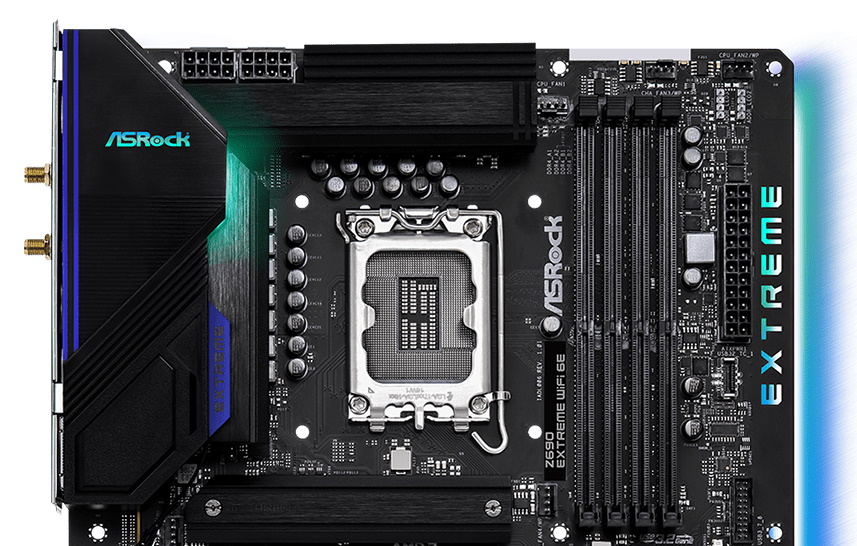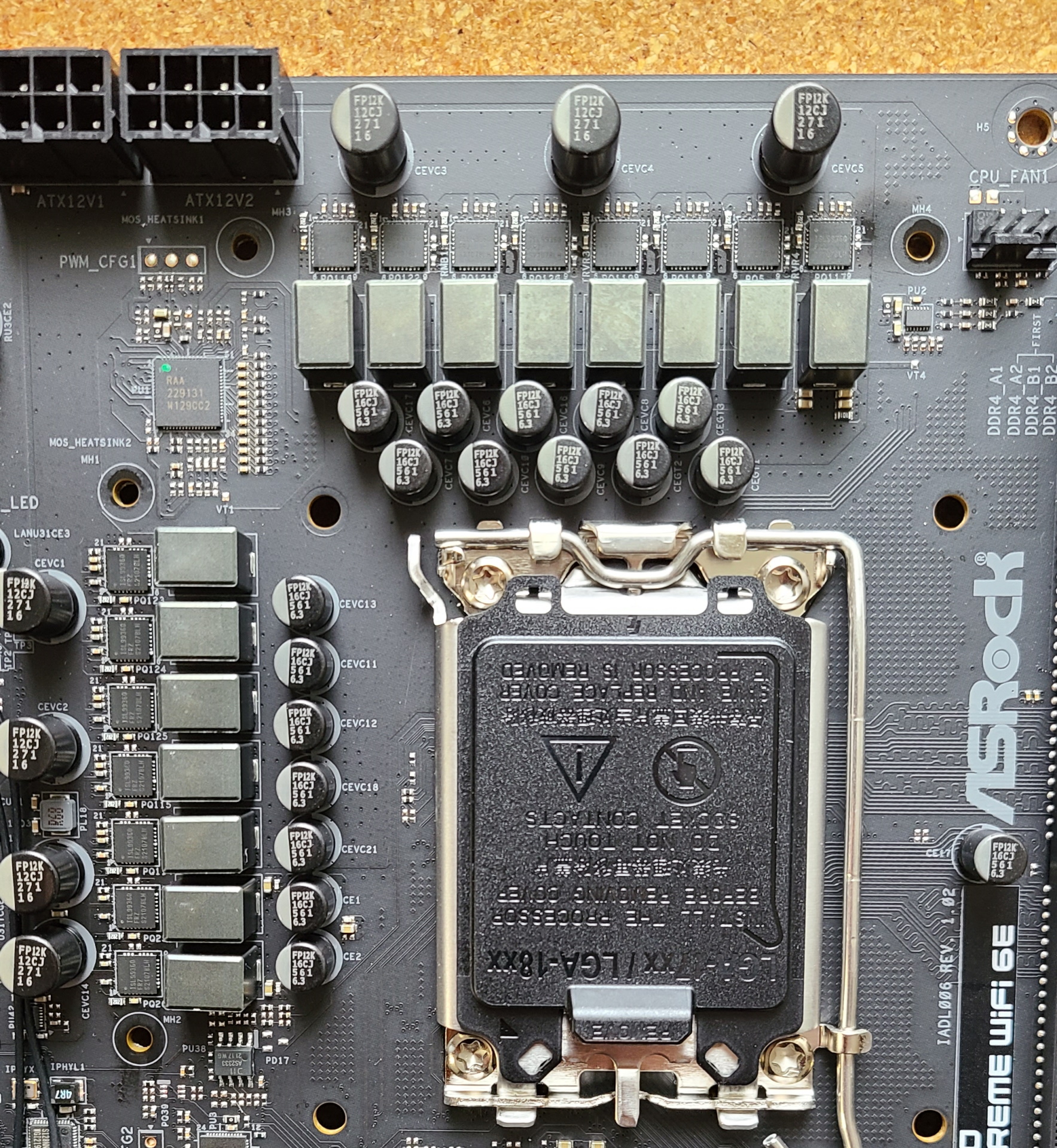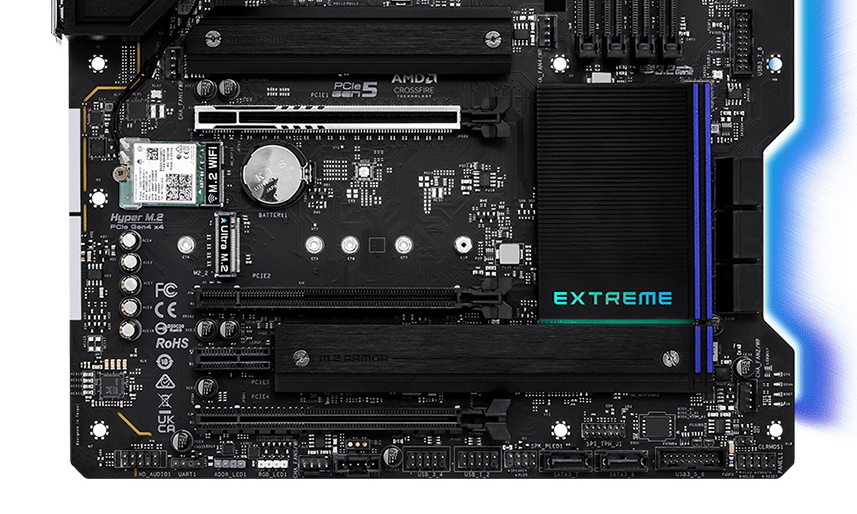Tom's Hardware Verdict
ASRock's Z690 Extreme WiFi 6E is a well-rounded and good-looking Z690 motherboard with a sub $200 price. The black and RGB-laden board comes with plenty of storage options sporting eight SATA ports and three M.2 sockets. If the rear USB count (five) isn’t a dealbreaker, it’s a top-notch budget Z690 offering around the $200 price point.
Pros
- +
Lower price than competition
- +
Wi-Fi 6E and dual Ethernet ports
- +
Eight SATA ports
- +
Bright RGBs (which could aslo be a con)
Cons
- -
Only five USB Type-A ports on rear IO
- -
Sub-par out-of-the-box performance on some tests
Why you can trust Tom's Hardware
ASRock’s Z690 Extreme WiFi 6E might imply it’s a high-end motherboard, the price (currently $196.99) is anything but. A step above the PG Velocita and below the premium Taichi, the Extreme comes with almost all the bells and whistles most users will want. This includes three M.2 sockets, eight SATA ports, dual 2.5 GbE ports and integrated Wi-Fi 6E, capable power delivery, and an all-black look with bright RGBs you’ll be proud to show off inside your chassis.
The Z690 Extreme’s performance during our testing depended on the benchmark. In general, single or lightly threaded benchmarks ran well, but heavily muilti-threaded results tended to be below average. For example, it excelled in Procyon Office but was slower in 7Zip, Handbrake and Cinebench. Outside of that, the results were average in other tests, including gaming and power consumption. If you want to get the most out of this board for multi-threaded tests, you’ll need to make some easy tweaks in the BIOS. Otherwise,this is a performant board. With only five type-A ports on the rear IO (with multiple headers for front panel ports), you’ll need to ensure that’s enough for your needs.
Below, we’ll take a detailed look into the features and specs to better understand how this budget Z690 motherboard stacks up against the competition and see if the Extreme earns a home on our best motherboards list. But before we get into all the details, here is a complete list of specifications from ASRock’s website.
Specifications: ASRock Z690 Extreme WiFi 6E
| Socket | LGA1700 |
| Chipset | Z690 |
| Form Factor | ATX |
| Voltage Regulator | 15 Phase (13 60A DrMOS MOSFETs for Vcore) |
| Video Ports | HDMI (v2.1) |
| Row 5 - Cell 0 | DisplayPort (v1.4 - 8K@60Hz) |
| USB Ports | (1) USB 3.2 Gen 2, Type-C (10 Gbps) |
| Row 7 - Cell 0 | (1) USB 3.2 Gen 2 (10 Gbps) |
| Row 8 - Cell 0 | (4) USB 3.2 Gen 1 (5 Gbps) |
| Network Jacks | (1) 2.5 GbE |
| Row 10 - Cell 0 | (1) GbE |
| Audio Jacks | (5) Analog + SPDIF |
| Legacy Ports/Jacks | PS/2 |
| Other Ports/Jack | ✗ |
| PCIe x16 | (1) v5.0 (x16) |
| Row 15 - Cell 0 | (1) v4.0 (x4) |
| Row 16 - Cell 0 | (1) v3.0 (x4) |
| PCIe x8 | ✗ |
| PCIe x4 | ✗ |
| PCIe x1 | (1) v.3.0 (x1) |
| CrossFire/SLI | AMD CrossFire |
| DIMM Slots | (4) DDR4 5333+(OC), 128GB Capacity |
| M.2 Sockets | (1) PCIe 4.0 x4 (64 Gbps) / PCIe (up to 80mm) |
| Row 23 - Cell 0 | (1) PCIe 3.0 x4 (32 Gbps) / PCIe + SATA (up to 80mm) |
| Row 24 - Cell 0 | (1) PCIe 4.0 x4 (64 Gbps) / PCIe (up to 110mm) |
| Row 25 - Cell 0 | Supports RAID 0/1/5 |
| U.2 Ports | ✗ |
| SATA Ports | (8) SATA3 6 Gbps (Supports RAID 0/1/5/10) |
| USB Headers | (1) USB v3.2 Gen 2x2, Type-C (20 Gbps) |
| Row 29 - Cell 0 | (2) USB v3.2 Gen 1 (5 Gbps) |
| Row 30 - Cell 0 | (2) USB v2.0 (480 Mbps) |
| Fan/Pump Headers | (7) 4-Pin (CPU, CPU/Water pump, Chassis/Water pump |
| RGB Headers | (3) aRGB (3-pin) |
| Row 33 - Cell 0 | (1) RGB (4-pin) |
| Diagnostics Panel | (4) POST LEDs |
| Internal Button/Switch | ✗ |
| SATA Controllers | ✗ |
| Ethernet Controller(s) | (1) Intel I219-V (GbE) |
| Row 38 - Cell 0 | (1) Realtek Dragon RTL8125BG (2.5 GbE) |
| Wi-Fi / Bluetooth | Intel AX210 Wi-Fi 6E (2x2 ax, MU-MIMO, 2.4/5/6 GHz, 160 MHz, BT 5.2) |
| USB Controllers | ASMedia ASM1074 |
| HD Audio Codec | Realtek ALC1220 |
| DDL/DTS | ✗ / ✗ |
| ✗ / ✗ | 3 Years |
Inside the Box of the ASRock Z690 Extreme WiFi 6E
Inside the box along with the motherboard, ASRock throws in a few accessories designed to get your system up and running without an additional trip to the store. There’s also a graphics card holder (which mounts to the board) to help support heavy video cards and prevent sagging. Below is a complete list of the included accessories.
- (4) SATA cables
- Wi-Fi antenna
- (3) M.2 screws
- (2) M.2 standoffs
- Velcro straps
- Extreme keycap
- Support DVD
- User Guide
Design of the ASRock Z690 Extreme WiFi 6E
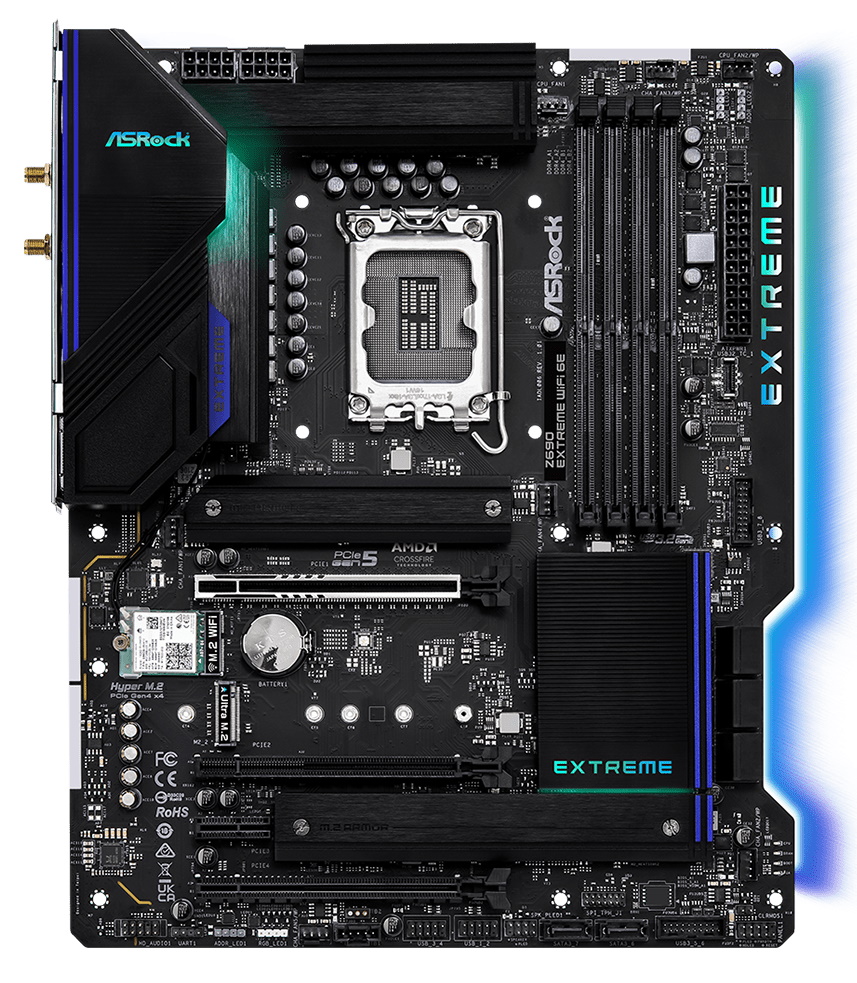
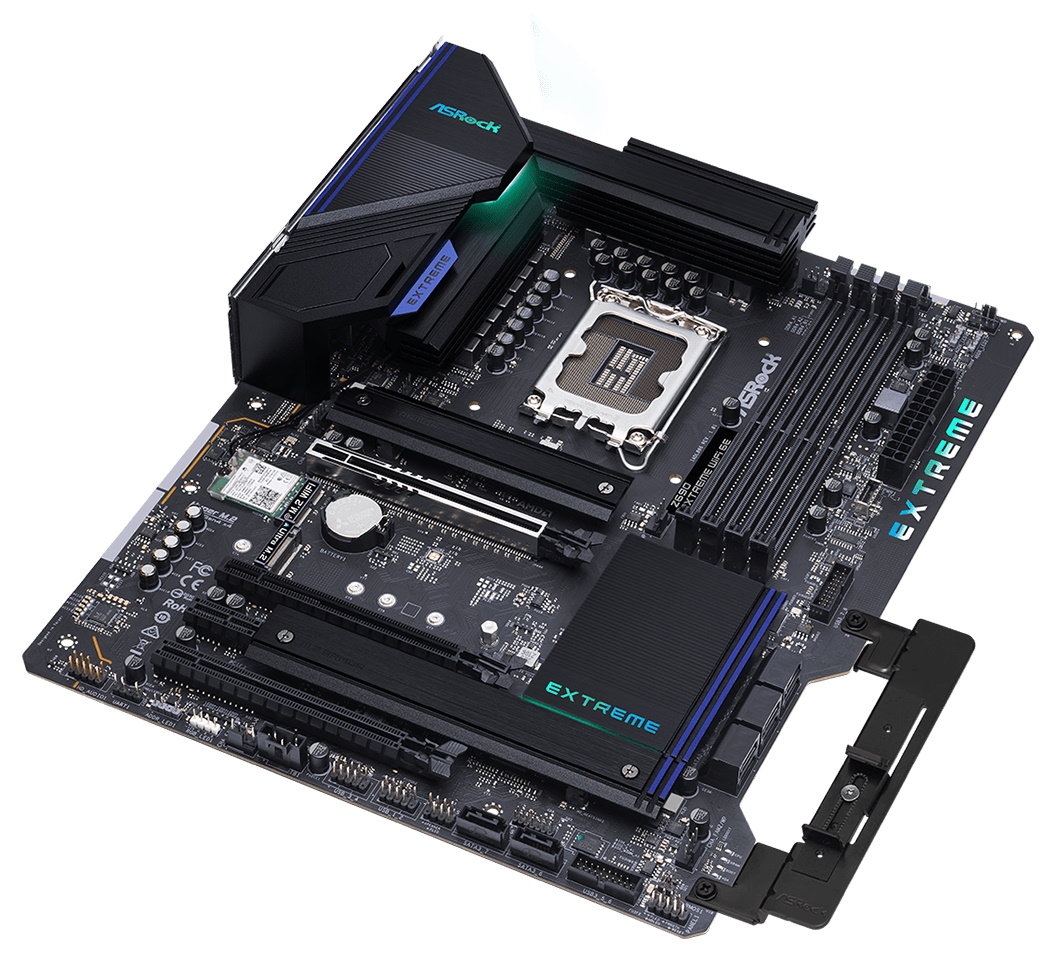

ASRock’s Z690 Extreme WiFi 6E is a good-looking board for the price. The black, 6-layer PCB with 2 ounces of copper traces has a large notch cut out of the PCB by the SATA ports, along with flat corners on the edges that sets it apart from its competitors. All heatsinks and shrouds are black, with a brushed aluminum finish. The chipset heatsink and rear IO shroud have blue accent pieces to break up the monotony of black. All slots (save for the primary PCIe slot) and sockets are black as well.
If you’re into RGB lighting, the Extreme has you covered, and then some. The chipset heatsink and rear IO cover have several RGBs underneath, illuminating those areas. Along the right edge on the back side of the board is an additional RGB strip that shines through the translucent “Extreme” branding along that same edge. The integrated RGBs are bright and the colors are saturated. If RGBs are your thing and you’re on a budget, the Extreme offers one of the more impressive light shows out of the box.
Starting with the top half of the board, we get a better look at the rear IO shroud and heatsink below. The shroud’s RGBs shine through ASRoc’sk branding, as well as reflecting off the top of the left VRM heatsink. Sporting a brushed aluminum finish, the VRM heatsinks have enough mass and surface area to keep the power bits below running within spec. Just above the VRM heatsinks are two 8-pin EPS connectors tol power the CPU (one required).
Get Tom's Hardware's best news and in-depth reviews, straight to your inbox.
Looking right, just past the socket and before the DRAM slots, is the first 4-pin fan header (CPU_FAN1). In total, there are six 4-pin headers scattered around the board, which all support 4-pin PWM and 3-pin DC fans with power output varying from 1A/12W (CPU header) to 2A/24W headers (CPU/Water Pump and Chassis/Water Pump headers). CPU_FAN2/WP and CHA_FAN1-5/WP auto-detect the type of fan in use. Fan control is handled through the BIOS or the A-Tune application.
Continuing right, we run into four unreinforced DRAM slots with a single-sided locking mechanism. ASRock says the Extreme supports up to 128GB of DDR4 5333+(OC), but your mileage may vary as reaching those speeds depends on individual hardware. We didn’t have any issues running our performance DDR4 4000 kit and expect there is plenty of headroom left, especially when using two sticks.
We pass by two more fan headers along the right edge and run into the first (of four) RGB headers. In this location, there are two 3-pin ARGB headers, while along the bottom edge of the board is a 4-pin RGB header and the third 3-pin ARGB header.
The right edge sports a unique design element with the word “Extreme” written out in translucent PCB layer, with the bright RGBs that line the entire right edge of the board lighting up the “Extreme” branding. Of course, if you’re not a fan or just want to turn it down or off, that’s easy too through the ASRock Polychrome software.
Offset around a half-inch from the edge, we run into the 24-pin ATX connector that powers the board, a front panel USB 3.2 Gen 2x2 (20 Gbps) Type-C header and a 19-pin front panel USB 3.2 Gen 1 (5 Gbps) header. Two additional USB 2.0 headers are found along the bottom edge.
Power delivery on the Z690 Extreme consists of 13 phases for Vcore. Power comes from the EPS connector(s) and onto a Renesas RAA229131 20-phase controller, where it’s delivered to the 13 60A Intersil ISL99360 SPS MOSFETs. The 780A for Vcore isn’t a lot compared to many Z690 boards, but the Extreme handled our Intel Core i9-12900K overclock with minimal fuss. We needed a bit more voltage at that same clock speed than most motherboards (details in the Overclocking section), but that didn’t hold us back for our overclocked settings.
Now on the bottom half of the board, the left side sports a fully exposed audio section centered around a Realtek ALC1220 chip/codec. You’ll also find five dedicated audio caps here. While this is last year’s flagship-class codec, most users will find this solution perfectly acceptable, especially for a sub-$200 board.
In the middle of the Extreme are three M.2 sockets (four if you count the Key-E Wi-Fi adapter), two of which have heatsinks. The top socket, M2_1, connects through the CPU, offering 64 Gbps of bandwidth through a PCIe 4.0 x4 interface. M2_2 connects through the chipset, supporting 80mm SATA and PCIe 3.0 x4 (32 Gbps) modules. The bottom socket supports up to 110mm PCIe 4.0 x4 devices and connects through the chipset. Note that there is some minimal lane sharing here: If a SATA-based storage device occupies M2_2, SATA port 7 is disabled. Additionally, the Z690 Extreme supports RAID0/1/5 on the M.2 sockets.
In the middle of the board are three full-length PCIe slots and one open-ended x1 slot for graphics and other PCIe-based devices. The top socket (PCIE1) connects through the CPU and offers the only PCIe 5.0 connectivity on the board at PCIe 5.0 x16. The other full-length slots connect through the chipset. The middle slot (PCIE2) runs PCIe 4.0 x4 and the bottom slot (PCIE4) runs at 3.0 x4 speeds. Lastly, the x1 size slot also sources its bandwidth through the chipset and runs at PCIe 3.0 x1. If you’re still into multi-GPU technology, the Z690 Extreme supports AMD Crossfire.
Moving past the chipset heatsink and onto the right edge, we run into six of the eight SATA ports. These run from the chipset, while SATA7/8 uses an ASMedia chip to borrow bandwidth. I like the notch that was cut out from the motherboard here, as not only does it give it a rare design element, but it also helps with cable management. These SATA ports support RAID0/1/5/10 modes. The other two SATA ports stick up from the bottom edge of the board and are not included in the RAID configuration.
The other feature worth mentioning in this area is the 4-LED POST status checker. Each LED represents a function during POST. If your system hangs during POST, the LED corresponding to the error (either Boot, VGA, DRAM or CPU) remains lit. For boards that don’t have the more detailed 2-character display, this is a good way to see where the problem is.
Across the bottom of the board are several exposed headers. You’ll find the usual, including additional USB ports and RGB headers and more. Below is a complete list from left to right.
- Front panel audio
- 3-pin ARGB header
- 4-pin RGB header
- 4-pin chassis fan header
- 5-pin Thunderbolt AIC header
- (2) USB 2.0 headers
- Power/LED speaker headers
- (2) SATA ports
- SPI TPM header
- USB 3.2 Gen 1 header
- System panel header
The rear IO area comes with a pre-installed IO plate. It sports a black-and-gray background, with easy-to-read gray port labels reminiscent of their PG Velocita line. There are only six USB ports on the rear IO which, for some users (me!), won’t be enough. There’s a USB 3.2 Gen 2 (10 Gbps) Type-C port, one USB 3.2 Gen 2 (10 Gbps) port and four Gen 1 (5 Gbps) ports (the green port is used for BIOS Flashback functionality). Additional ports are available through headers.
Video output consists of Displayport and HDMI ports. The Z690 Extreme offers dual Ethernet ports, one GbE and the other 2.5 GbE. Additional ports include the Wi-Fi 6E antenna connectors, 5-plug analog plus SPDIF audio stack, a legacy PS/2 port, and the BIOS Flashback button.
MORE: Best Motherboards
MORE: How To Choose A Motherboard
MORE: All Motherboard Content

Joe Shields is a staff writer at Tom’s Hardware. He reviews motherboards and PC components.
-
enorl76 Board looks like a great value.Reply
Although I question... why is anybody in the world in 2022 still putting PS/2 ports on mobo's???
I got rid of last PS/2 keyboard about a decade ago. -
closs.sebastien yes, they could remove the ps2... I don't even know any device that exist these days..Reply
how do you explain the slow performances? -
shady28 ReplyTom Sunday said:I have never been a great fan of ASRock, but the ‘Z690 Extreme’ appears to be a good deal on the surface. With the new 700 MB series arriving in a few months time, I wonder what the prices for the ASRock Extreme will be then at the local Computer Show with no sales tax, cash in hand and dropped across the folding table. $110? I am sure that the ‘Bangladesh Boys’ will have a slew of them and perhaps bundling those with outgoing and discounted DDR4 and a Core i5-12400F of which many are already seen at the show at give-away prices! Perfect for the man on the street seeking a quick-fix and with all the bells and whistles. Indeed the times are right for big discounts and even for me with already eyeing previously used 30-gen GPU’s having flooded by now the tables here!
As far as deals, you can get an EVGA Classified Z690 for $299 from EVGA now if you can fit a EATX. That's like $330 off a normally $629 board.
A little more than $110, but just put that in your sig and you'll get oohs and aahhs. -
ocer9999 Indeed, the Z690 Extreme is a great deal under 200$, all around motherboard with solid VRMs as well Wifi 6E, you can't really beat it. Always had good luck with their boards, if I was on the market for a new motherboard, this would definitely be one on my list.Reply
